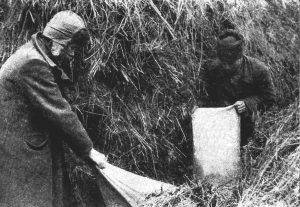Sat May 16 05:35:43 2020
<8f79fcda> <https://en.m.wikipedia.org/wiki/Kulak|https://en.m.wikipedia.org/wiki/Kulak>
— Kulak
— Kulak (; Russian: кула́к, tr. kulak, IPA: [kʊˈlak] (listen), plural кулаки́, “fist”, by extension “tight-fisted”; kurkuli in Ukraine, but also used in Russian texts in Ukrainian contexts), or golchomags (Azerbaijani: qolçomaq, plural qolçomaqlar) was the term describing peasants with over 8 acres (3.2 hectares) of land towards the end of the Russian Empire. In the early Soviet Union, particularly Soviet Russia and Azerbaijan, kulak became a vague reference to property ownership among peasants, who were considered “hesitating” allies of the revolution. The kulaks were decimated following orders by Joseph Stalin, to guarantee collectivisation in the 1930s.
The word kulak originally referred to former peasants in the Russian Empire who became wealthier during the Stolypin reform from 1906 to 1914. During the Russian Revolution, the label of kulak was used to chastise peasants who withheld grain from the Bolsheviks. According to political theories of Marxism–Leninism in the early 20th century, the kulaks were class enemies of the poorer peasants. Vladimir Lenin described them as “bloodsuckers, vampires, plunderers of the people and profiteers, who fatten on famine”, declaring revolution against them to liberate poor peasants, farm laborers, and proletariat (the much smaller class of urban and industrial workers).During the first five-year plan, Stalin’s all-out campaign to take ownership and organisation from the peasantry meant “peasants with a couple of cows or five or six acres [about 2 ha] more than their neighbors” were labeled kulaks. Under dekulakization, government officials violently seized farms and killed resisters, deported others to labor camps, and drove many to migrate to the cities following the loss of their property to the collective.
